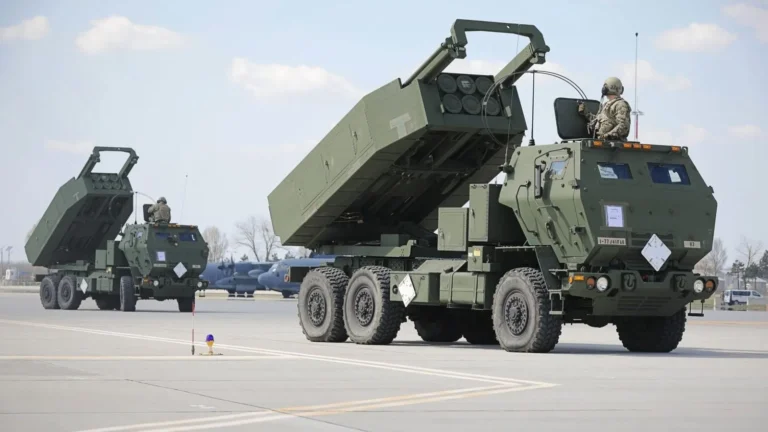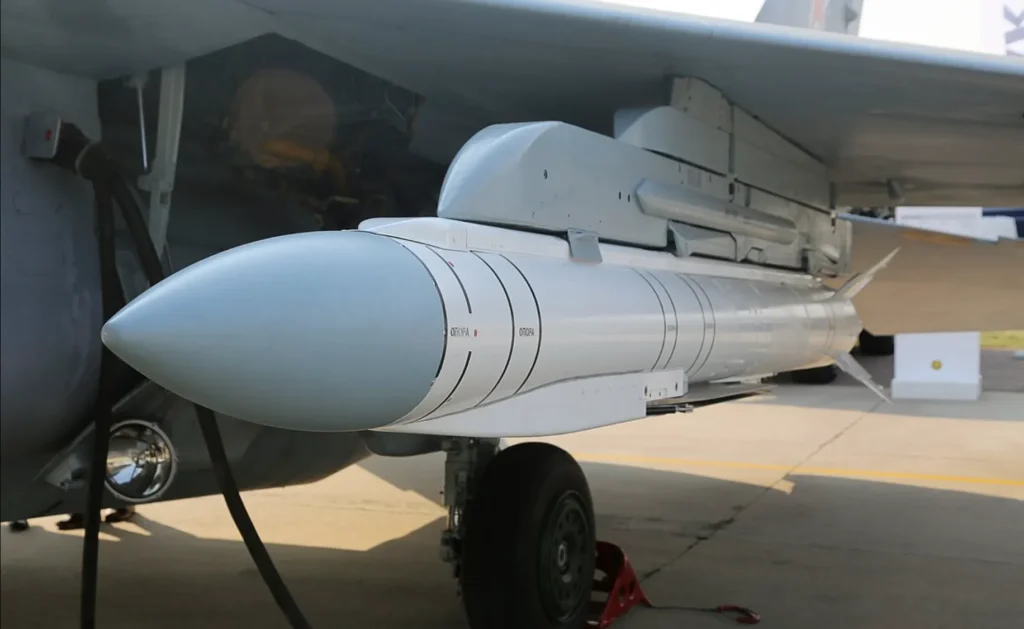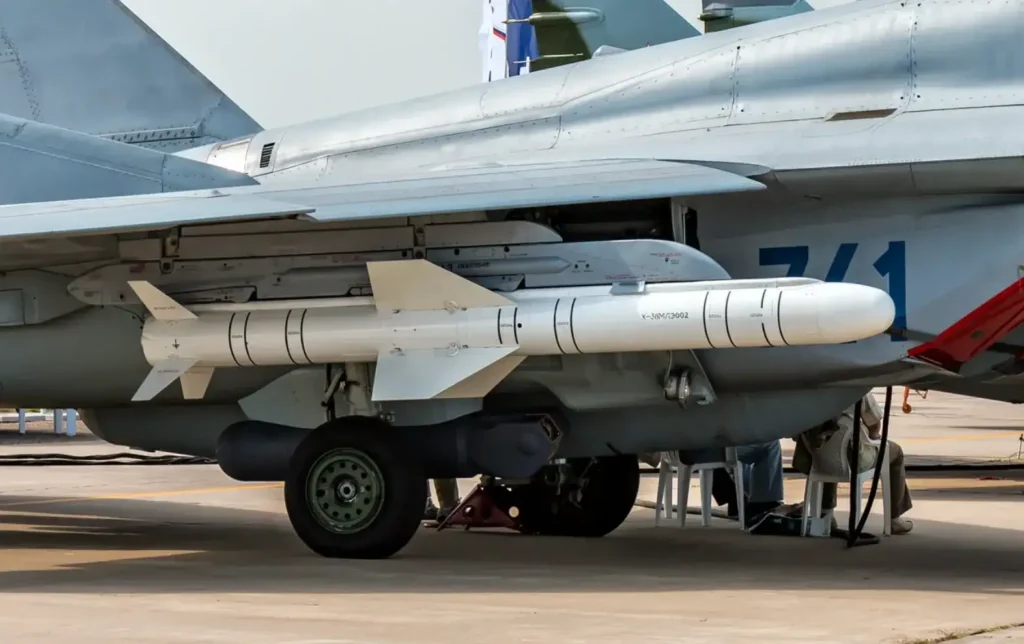Follow Us:

Share
As September dawned, the city of Kharkiv, Ukraine, endured relentless shelling, marking a stark escalation in the ongoing conflict. Among the various weapons deployed by Russia, a newly developed hybrid missile-bomb, known as the Grom-E1 Missile Bomb, made its debut in the attacks, catching the attention of both military analysts and the Ukrainian defense.
This weapon represents a unique blend of missile and bomb technology, a strategic asset Russia has produced in limited quantities since its initial presentation in the mid-2000s. Here’s an in-depth look at the Grom E1 Missile bomb, its capabilities, and its implications for the battlefield.
The Grom-E1 missile bomb is not merely a conventional missile or an aerial bomb; it’s a sophisticated combination of both. Unlike traditional guided bombs with limited reach, the Grom-E1’s unique structure features an engine that extends its operational range, giving it distinct advantages over standard bombs.

After being dropped from an aircraft, the Grom-E1 missile bomb unfolds its wings and initiates its engine, allowing it to reach targets up to 120 kilometers away. This range is significantly greater than a typical guided bomb, which usually maxes out between 60 and 80 kilometers, based on available estimates.
For those familiar with advanced weapons, the Grom-E1 has been likened to the American JDAM-ER bomb, albeit with notable differences. While the JDAM-ER is celebrated for its precision, Ukrainian Air Force officials note that the Grom-E1 lacks the same degree of accuracy.
In their view, the Grom-E1 missile bomb, although technologically advanced, has yet to demonstrate pinpoint targeting capabilities, with civilian infrastructure often bearing the brunt of its recent deployment in Kharkiv.
The Grom-E1 missile bomb weighs in at 594 kilograms, with a warhead that accounts for 315 kilograms of its mass. A variant known as the Grom-E2 exists for scenarios where range is less critical. By removing the engine, the Grom-E2 can carry a heavier warhead, adding an additional 165 kilograms.
However, the range of the Grom-E2 missile bomb is almost halved, limiting its reach but enhancing its destructive power. This flexibility in configurations allows Russian forces to choose between range and payload, depending on the tactical requirements.

While developed based on the Kh-38 missile, the Grom-E1 boasts extended range, enabling it to strike from a considerable distance. The Kh-38, in contrast, has a maximum range of about 40 kilometers. The engine on the Grom-E1 grants it a distinct advantage, effectively turning it into a long-range, stand-off weapon.
The Tactical Missile Armament Corporation, Russia’s leading missile manufacturer, first introduced the Grom-E1 Missile Bomb to the public in 2015, with testing for both Grom-E1 and Grom-E2 variants reportedly completed by 2019.

However, large-scale production has been slow, with only limited units manufactured monthly, estimated at around four units. It remains uncertain whether the Grom-E1 bomb has been fully adopted into Russian military service or if it’s produced in significant quantities for regular use.
Ukraine first reported the Grom-E1’s use in combat in March 2023 when the weapon was discovered undetonated in the Donetsk region. Since then, Russia has sporadically used the Grom-E1 in targeted attacks, including strikes on Kupiansk in the Kharkiv region in late 2023, and an early 2024 assault on Kherson. The recent attack on Kharkiv marks the latest known use of the Grom-E1 in the conflict, with substantial damage reported in civilian areas.
One of the key differentiators between the Grom-E1 and standard aerial bombs lies in its extended range. Traditional aerial bombs often feature additional wings for greater reach, enabling them to hit targets from approximately 65 kilometers away. However, without a propulsion system, their range is limited. The Grom-E1, on the other hand, combines wings and an engine, making it a formidable long-range weapon.
For Ukraine, the threat posed by the Grom E1 missile bomb is particularly difficult to counter due to limited air defense capabilities against this type of hybrid missile-bomb. Ukraine’s primary defense against these attacks involves targeting the aircraft and airfields from which they are launched.
Given the challenges, Ukrainian officials have appealed to Western allies for long-range missiles to enable strikes on Russian airbases near the border. These airfields, believed to number around two dozen, serve as strategic launch points for Grom-E1 bomb attacks, and Ukraine hopes that disabling them could mitigate the risk of further shelling.
As seen in Kharkiv, Russia’s use of the Grom E1 missile bomb has led to considerable damage to civilian structures, with claims of missile accuracy called into question. Despite Russia’s assertions of the weapon’s precision, the recent strikes on Kharkiv have predominantly impacted non-military targets, heightening concerns about the Grom-E1’s potential to cause indiscriminate damage in urban settings.
Russia has just successfully tested its new “Grom-E1” hybrid of a cruise missile and a gliding bomb on civilians in Ukrainian Kharkiv region. Russian military wants to thank @POTUS and @Bundeskanzler for having made this test possible by extended protection of Russian airfields. pic.twitter.com/WLDq208w3K
— Sergej Sumlenny, LL.M (@sumlenny) October 29, 2024
In a broader sense, the Grom-E1’s deployment underlines Russia’s willingness to leverage new technology in its arsenal, even if that technology lacks the reliability and precision of Western counterparts. As the conflict continues, weapons like the Grom-E1 missile bomb highlight the evolving nature of warfare and the ever-growing challenges faced by those attempting to defend against it.
Share
Defense Feeds is publication focusing on informing, engaging, and empowering the world by providing accurate information from defense technology.
Powered by Defense Feeds © 2025 – All rights reserved.